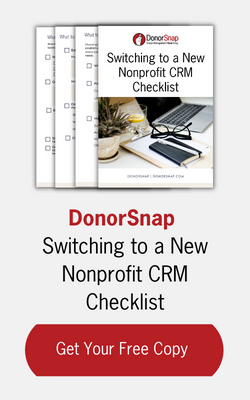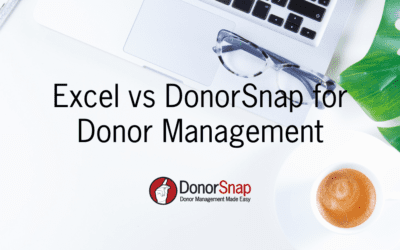The selection of a Donor Management system is an important decision for all non profits regardless of size. The system you choose will be your tool for interacting with contacts and donors, analyzing and creating communications and so much more. Since your donors and potential donors are vital to providing some or all of the funding your organization requires to accomplish its goal, it’s especially important to utilize a Donor Management System that fits all of your needs. And since every Donor Management package is slightly different, you’ll need to carefully examine and possibly even try the package before making your final decision.
One of the most critical aspects of the package you select actually has to do with the capabilities and nature of your organization. Specifically:
In-House Computer Capabilities:
Do you plan on running the software on your in-house computer or do you plan on utilizing an Internet-based (Cloud) system? Unless your organization has a strong in-house information technology department (and 99% of non profits cannot afford this luxury), your organization may be better served by looking to an Internet-based solution. Here’s why:
- No software installation required on any computer
- Information is backed up nightly to a secure location
- High up-time rate – 99%!
- Not prone to hardware malfunction
- Protection from computer hackers
- You’re not locked into a specific computer or operating system. So use those donated Macs or PCs – or a combination of both! Remember, you can access the program from any computer with an Internet connection.
If you do decide to go with an in-house solution, you’ll need to decide if it will be a single user or multi-user solution. Unless you have an in-house network, more than likely the solution will need to be a single-user solution. This means that the software and database will be stored on one machine (and only one) and that anyone wanting to work on the database will require access to this computer. If you have a network, you can expand your search to software that operates over a LAN (local area network). In either case, you’ll have to narrow your list of software products to match the operating system and computer configuration that you have (for example, there are only a few MAC-based single user software products available for Donor Management).
Development Staff Size & Organization
Generally, the larger your staff, the more likely you would be to have an in-house computer system that is multi user and provides slightly faster response times. An organization with 2-3 people in their development area would be more likely to have a budget capable of supporting an in-house solution and the expertise to design, install and implement the product. BlackBaud ® is the largest distributor of Donor Management databases for in-house use and generally found in most of the larger development departments. But you’ll need to be prepared financially, since these packages have significant costs once you factor in the software license, number of users, annual license, training and implementation design costs. The software is very powerful and comprehensive.
Basic Features
Once you’ve assessed your organizational issues, you can turn your attention to features and benefits of specific packages. In general, most quality Donor Management products should have the following features (Note – the reference of “contacts” includes both existing donors and people and organizations you may be cultivating for future donations.):
- Track unlimited number of contacts, donations, interactions, notes, etc. You don’t want to outgrow your system too soon.
- Show relationship between various contacts. Do you have contacts that work for the same organization, are related, live at the same address or tend to like to socialize together. You should be able to track this information to save on mailing costs, target particular groups or tailor your event invitations.
- Track volunteer activities. Many Contacts are also volunteers. You should monitor what events people volunteer for and what their level of participation is. The best place to start when planning your next event is to get a list of who’s worked your past events.
- Track interactions and specific notes relating to a contact
- Track pledges and send reminders. Having the ability to send gentle reminders via email or regular mail to those that have pledged money is important. The system should automatically keep track of the dates the next pledge payments are due.
- Reports depicting information about donations received
- Ability to produce mailing labels for a selected segment of the database. Not all mailings should go to all contacts. Carefully select the target audience to match the cost of the mailing with the expected benefits.
- Ability to create your own user defined fields. No two nonprofits are the same. That is why you need user-defined fields to capture the information that is unique to your organization.
- Generate donor statements. Not every Contact wants a statement but you need to be able to generate them easily, if needed, without having to export data to excel or some other program.
Advanced Features:
In addition to the above mentioned standard features, you should consider a system that has the following:
- Layered security that allows you to grant individualized access to portions of the database. For instance, volunteers are a great source of help for entering and updating contact information, but you may not want them to have access to confidential information such as donation amounts. In that case, you can simply grant your volunteers access to the portions of the database they need to use without worrying about confidential information being viewed.
- Ability to store multiple names for a contact and the ability to properly recreate these names on reports, labels, letters, etc. This is helpful in households that have two family names, but unfortunately, most systems force you into addressing mailings to only one name or the other. That’s why it’s important to look for a system that allows you to dynamically build up multiple names for both mailing and salutation purposes that address both parties in the household equitably.
- Ability to categorize donations by not only type of donation, but also by campaigns and appeals. Knowing the amount of money you received from someone is important. However, knowing what causes (campaigns) your contact base is willing to donate to and what the most effective way of asking for the donation is critical so that you can take a targeted approach to your contacts that match their style and preferences.
- Comparative reports over different periods of time to track donation patterns. You need to be able to identify sudden drops or increases in donations from specific contacts. There may be an issue that you need to address to ensure that you don’t give a contact a reason to find another organization to support.
- Ability to automatically notify key organization individuals via email of donations received from Donors that they may interact with. As donations get tighter, it’s critical for contacts to be acknowledged by significant individuals in the organization. Board members or other key constituents should be alerted immediately of any donation received from someone they may have introduced to the organization.
- Import new contact records from external sources via Excel, CSV file or other common transfer format so that you can quickly and efficiently update your contact database.
- Extraction and letter writing tools that will allow you to select specific contacts and customize correspondence with them. Ideally, you’ll have a system that has the ability within the system to produce the documents so that you don’t need to try and integrate with third party products such as Microsoft Word or Mail Merge. These are excellent programs but at times present cross compatibility issues when versions are updated.
Choosing a donor management system is an important decision. To find the best fit for your nonprofit, be sure to assess the needs and capabilities of your organization and then carefully study the features and benefits of the systems you’re considering. A little research now can save you time, money and headaches down the road.



